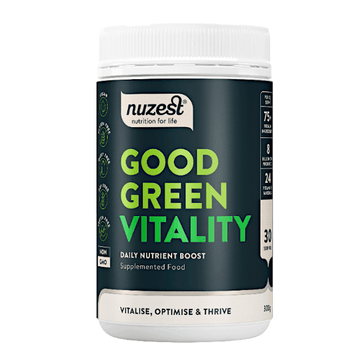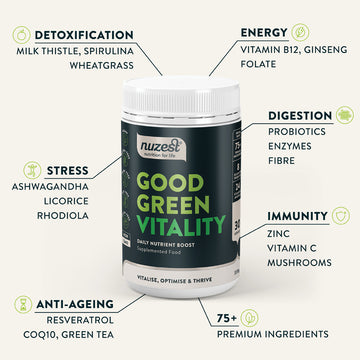What you put into your body can affect your sense of wellbeing and mood.
There is a growing body of evidence indicating that nutrition may play an important role in mental health. Just like the other organs in your body, your brain needs plenty of nutrients to function optimally.
Nuzest's flagship product, Good Green Vitality, is built on a real food base of fruits, vegetables, herbs and superfoods which contain powerful antioxidants, phytonutrients and adaptogens, all handpicked by our scientific researchers for their cognitive benefits and stress-busting abilities.
We have highlighted 5 nutrients found in Good Green Vitality that have the potential to minimise stress and optimise your mental wellness. These are only a few of the many ingredients that work synergistically to optimise brain health.
Ashwagandha
Ashwagandha, known as Indian ginseng, or Indian winter cherry, is a traditional medicinal herb that has been used for many years. It is commonly known as an adaptogen, which helps improve tolerance to stress.
In a review of placebo vs treatment controlled studies, ashwagandha significantly reduced anxiety and stress. Good Green Vitality uses 80mg of ashwagandha root, which provides many beneficial compounds.
Zinc
Zinc is a commonly known trace mineral, which means we do not need vast amounts, yet it is responsible for many of the body's functions - metabolism, DNA synthesis, immune function, and much more.
Zinc deficiency is associated with depression and anxiety. When we become stressed, the level of brain-derived neurotrophic factor (BDNF) in our brains falls; this can develop into depression and anxiety. Zinc can help elevate levels of BDNF in the areas of our brain that control our emotions. Many studies have supported the notion that those with anxiety and depression tend to have low levels of zinc in the body.
Good Green Vitality contains 12mg of Zinc citrate, which is considered one of, if not the most, absorbable forms of zinc, with absorption rates greater than 61%.
Rhodiola
Rhodiola Rosea, or golden root, is a culinary and medicinal herb that grows throughout Central Asia, North America and the mountainous regions of Europe. Good Green Vitality contains 100mg of Rhodiola plant extract; this is commonly used as an ‘adaptogenic’ herb, helping the body deal more effectively with stress - it is thought to improve physical and mental performance and resilience.
Panax Ginseng
The root of the Panax ginseng plant has been used in Chinese herbal medicine for thousands of years, primarily as a calming agent and adaptogen. Panax ginseng is good for the body and the mind. We chose to include a high-quality Panax ginseng extract for its brain-boosting, stress-busting abilities - with 100mg in one serving of Good Green Vitality. It is well known for its potential to boost mood, protect the brain against oxidative stress and minimise mental fatigue.
Bioflavonoids
Good Green Vitality contains an array of bioflavonoids. Bioflavonoids are naturally occurring compounds found in many plants and fungi foods. They are considered potent antioxidants and exert a range of health benefits, including neural benefits. Preliminary evidence suggests that bioflavonoids can help to improve cognition and memory.
Different bioflavonoids have slightly different actions in the body, and so, by providing a spectrum of flavonoid compounds, there is the optimal opportunity to support overall health.
Do you want to know more about Good Green Vitality? Read our blog 'The Top Five Ingredients Of Good Green Vitality'.
References
-
https://www.ncbi.nlm.nih.gov/pmc/articles/PMC4270108/
-
https://pubmed.ncbi.nlm.nih.gov/21036578/
-
https://www.ncbi.nlm.nih.gov/pmc/articles/PMC5386131/
-
https://pubmed.ncbi.nlm.nih.gov/15982990/
-
https://www.researchgate.net/publication/264599595_The_effects_of_flavonoid_and_other_polyphenol_consumption_on_cognitive_function_A_systematic_review_of_human_experimental_and_epidemiological_studies
-
https://www.ncbi.nlm.nih.gov/pmc/articles/PMC2732010/
-
https://pubmed.ncbi.nlm.nih.gov/33632103/
-
https://www.ncbi.nlm.nih.gov/pmc/articles/PMC3738454/















